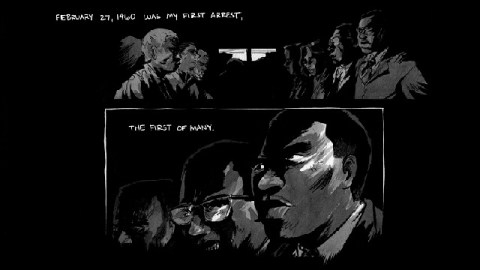John Lewis and Civil Rights March on in a New Graphic Novel

This past weekend people gathered in the nation’s capitol to mark the 50th anniversary of Dr. Martin Luther King, Jr.’s “I Have a Dream” speech that was part of the March on Washington for Jobs and Freedom in 1963. Of the ten people who spoke on that day, only one remains—Congressman John Lewis. Congressman Lewis stood at the podium on the steps of the Lincoln Memorial last Saturday and delivered a speech not only reminding us of the past, but also calling on us to continue to march into the future towards a more tolerant, more united America. For John Lewis, the march goes on. In March: Book One, co-written by Congressman Lewis and Andrew Aydin and illustrated by Nate Powell, the life and ideas of Congressman Lewis come powerfully alive in words and pictures for a whole new generation. Like Dr. King, Congressman Lewis knows how to preach, and March: Book One is an unforgettable sermon.
Ironically, Congressman Lewis credits a comic book—Martin Luther King and the Montgomery Story (published in 1957 by The Fellowship of Reconciliation or “FOR” and which you can read here)—as the beginning of the long journey that leads to March: Book One. FOR activist James Lawson helped Lewis understand the ideas of non-violent resistance and peaceful political activism. “His words liberated me,” Lewis remembers in March. “I thought, this is it… this is the way out.” One of the most remarkable and important strengths of March is its ability to bring the fine details of the Civil Rights Movement—the people, places, and events that fall short of the “I Have a Dream” mountaintop or even Lewis’ own, almost mythic moment on Edmund Pettus Bridge in Selma, Alabama now known as on as “Bloody Sunday”—back to vivid life.
This is history not to be forgotten at dire risk to our democracy, and Powell’s pictures stick in your head in a way that dry textbooks don’t. When Lewis recalls February 27, 1960 as the date of “my first arrest, the first of many,” Powell depicts the darkness and uncertainty of that moment with dramatic visual darkness (image shown above), although you never lose the glimmer of hope that love will win out in the end. Similarly, when March touches upon the events of “Bloody Sunday” in its opening, Powell’s images capture the tension leading up to the chaos of violence that resulted in Lewis’ fractured skull. “May we have a word with the major?” the marchers ask politely, only to have bullhorns bark back, “There is no word to be had!” Powell puts the police’s sharp words within jagged, razor-sharp word bubbles that match the razor-sharp teeth of the police dogs straining against their leashes. All these small details add up to a larger effect of putting you right there, beside Lewis and his associates, feeling the fear, but somehow finding the courage within to march on.
March makes equally effective use of the graphic novel’s Proustian ability to travel through time through visual cues. One moment we’re on Pettus Bridge, the next we’re watching young “Bob” (Lewis’ family nickname) preaching to his parents’ chickens, the next we’re waiting with the elderly congressman in his office for the inauguration of America’s first African-American president. What ties all these moments together is the spirit of Congressman Lewis himself—proud, passionate, warm, loving, humble, and, above all, generous. Although he speaks of the “spirit of history taking hold” of his life and setting him on the “way of peace, the way of love, the way of non-violence,” John Lewis’ own indomitable spirit will inspire you to read his story and, perhaps, join his battle.
The final image of March: Book One is that of a cell phone ringing. Will we ignore it, or will we answer the call? “Almost 50 years ago, I gave a little blood on that bridge in Selma, Alabama, for the right to vote,” Congressman Lewis said last Saturday. “I am not going to stand by and let the Supreme Court take the right to vote away from us!” “So hang in there, keep the faith,” Lewis continued. “I got arrested 40 times during the ’60s, beaten, bloodied and unconscious. I’m not tired, I’m not weary. I’m not prepared to sit down and give up. I am ready to fight and continue to fight, and you must fight.” The seemingly endless “national dialogue on race” continues, the battle for equality rages on, and John Lewis—last man standing from that unforgettable day in Washington half a century ago—remains a tower of power in the middle of it all. March: Book One by its title alone promises more to come, not just because it’s a story of the past left incomplete, but also because it’s a story still being written today.
[Image: “February 27, 1960 was my first arrest, the first of many.” Panel from March: Book One, by John Lewis, Andrew Aydin, and Nate Powell.]
[Many thanks to Top Shelf Productions for the image above from and a review copy of March: Book One, by John Lewis, Andrew Aydin, and Nate Powell.]





